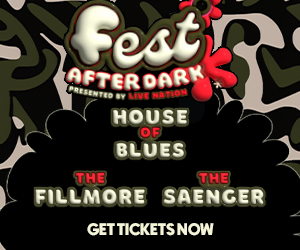Last week, I met with representatives of the VCPORA (Vieux Carre Property Owners and Residents Association). This is the group that’s been behind the very public, very loud (how ironic) protest against “noise” in the Quarter. Most of that noise is, of course, music. Somehow crowd noise, which on average is much louder than most music, never gets factored into their complaints.
But they and I agreed that the rhetoric surrounding the noise (music) issue is polarizing public opinion. We did reach a consensus that there’s a “loud” problem. It’s an issue that needs to be addressed, but a much broader representation of the city’s constituency needs to participate in the process to revise the ordinance. There may be many more people than the very vocal VCPORA that aren’t opposed to the noise in the Quarter. Who knows? How many people really complain?
The first portion of the revision was introduced last week by Councilwoman Gisleson-Palmer and it addressed speaker placement in the French Quarter and in the Downtown Development District (not on Frenchmen Street). Speakers must be placed no closer than 10 feet from the front door and they must face inward for businesses with a liquor license. Other retail establishments without a liquor license must position speakers 20 feet from the door, with sound facing inward.
However, this ordinance could potentially do away with live music at places like the Market Café and the Gazebo, near North Peters and St Philip.
Frenchmen Street lies within a special zoning “Cultural Overlay District” that has different requirements of businesses that operate there. For example, doors of clubs in the district are required to be closed. There can only be so many non-restaurant businesses with alcoholic beverage licenses who can offer live music. If your business is considered a restaurant (over 50 percent of revenues are derived from food sales), then you may offer only music that’s played by an acoustic group of no more than three people.
Clearly, Frenchmen Street music clubs may have issues, and the zoning in this area must be revised if the street is to continue to be known as a hotbed of local, authentic music. It’s too restrictive.
Even though the first attempt to revise the noise ordinance doesn’t apply to Frenchmen Street, it’s clear that the VCPORA group, French Quarter Citizens, hearnolamusic.org and their attorney, Stuart Smith, are taking a hard look not only at the French Quarter but at Frenchmen Street as well, as evidenced by the crackdown on Frenchmen Street a couple of weeks ago and a lawsuit filed against the Balcony Music Club. A new target—Frenchmen—has been identified, and it could be only a matter of time before music on Frenchmen is squelched.
Smith has lots of money to put behind politics he supports; when he wants something his way, he throws money at it. Coincidentally, the Market Café and the Gazebo are a half-block from his apartment on St. Philip Street, which he only occupies part time (he owns a plush apartment in Miami as well), and these venues were the first targets in his crusade against music some years ago. Smith manipulates public opinion and politics (his way) via cash, apparently. This is wrong. It’s not the way a democracy is supposed to work. Money shouldn’t be able to buy enough clout, public relations professionals and noise “experts” to influence public opinion without the general public’s option being heard. But in his case, it most certainly does (read previous blogs about Smith’s purchase of hearnolamusic.org).
Please read this revealing article on Smith’s political ties and how he uses his wealth to devise tactics to control public opinion and political outcomes. A fairly recent list of Smith’s political contributions can be seen here.
The controversy between the anti-noise groups (which are obviously backed by Smith) versus the businesses and citizens who support music continues. Robert Watters, of the French Quarter Management District, and the current head of the Bourbon Street Business Alliance, seeks to give more citizens access to the ordinance revision process with a discussion forum that will be open to the public next week (date and place not announced as of this writing). At least this forum will allow interested parties to participate in the process democratically, since most of the constituency that will be affected by the ordinance—French Quarter and Frenchmen Street businesses and residents—have not really had a voice in the process thus far. Unfortunately, they don’t have a well-heeled angel like Mr. Smith to fund and to promote their interests with a major public relations push. Perhaps airing issues and problems publicly will help the two sides come to a consensus in a more democratic manner.
Last week, the Eagle Saloon—one of the city’s important remaining historical jazz properties—was defaced by graffiti.
One of our readers, Nita Hemeter, wrote in outrage:
Regarding the recent defacing of the historic jazz landmarks on South Rampart Street: this is another sad reminder of the decay these buildings have suffered through. This should be an impetus for the city, the state, historic preservation groups, the National Park Service, the various tourism promotion organizations, and all other concerned individuals who care about the history of New Orleans and its priceless jazz heritage to step in and save these buildings.
It is outrageous that these properties are in the hands of an individual and a group of non-New Orleans residents who are either incapable of restoring them or are unwilling to do so. Instead, they have allowed these structures to deteriorate. These three buildings are some of the most historically authentic in relation to the city’s rightful claim to being the Birthplace of Jazz.
Visitors come to New Orleans from all over the world to experience our food, our architecture and – especially – our music. These buildings, if restored and opened to the public, would be a
yet another priceless tourist attraction.
Among the amenities I am envisioning for one or more of these buildings are venues for the performance of New Orleans jazz, something that millions of people come to New Orleans to hear. This
could take some of the onus off of Bourbon Street where loud, blaring music often drowns out the non-amplified sounds of traditional jazz coming from the few French Quarter clubs where it is performed. The soon-to-be-completed streetcar line down Loyola Avenue could take people a block away from these buildings, thus avoiding the congestion of Bourbon and Frenchmen streets.
It saddens me every time I look at these buildings and think about Louis Armstrong and our musical fathers and mothers who must be weeping in heaven at their decrepit condition. Don’t we owe
these giants of New Orleans music who contributed so much to our culture the decency of preserving their heritage? —Nita Hemeter, New Orleans
Nita, I could not agree with you more. I wonder why our city allows historic structures such as these to deteriorate. The many preservation groups complain in protest—as do we—but who has the “teeth” to compel negligent owners to restore these properties without masses of red tape? These are not just old buildings; they are a part of our legacy of our music and our city’s history. I’d challenge the City Council to find a way to make sure these historical properties are preserved and renovated—before they, and our musical legacy, crumble into dust once again.




